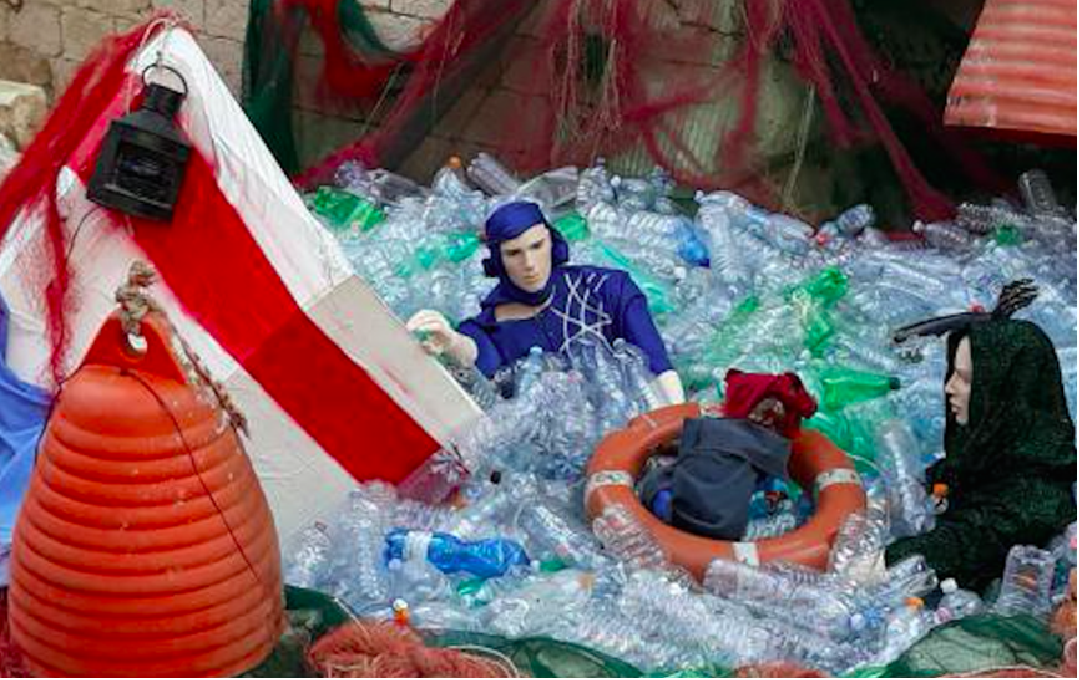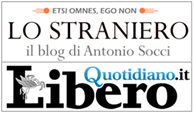 This is not a spoof. This is an actual 'Bergoglian' Nativity scene in Italy depicting the Holy Family as migrants submerged in a sea of empties!
The 'migrant Christ' theorized by the church of Bergoglio
This is not a spoof. This is an actual 'Bergoglian' Nativity scene in Italy depicting the Holy Family as migrants submerged in a sea of empties!
The 'migrant Christ' theorized by the church of Bergoglio
has nothing to do with Jesus of the Gospels
Translated from

December 10, 2018
Since 2013, the year we got Papa Bergoglio, unfailingly every Christmas, the idea is promoted that the Holy Family was a family of migrants. With an obvious political subtext.
This year, the pope has even asked the ‘Migrant Section’ of one of the Vatican dicasteries, to send a letter to an Italian prest that ends with the valediction,
“In Cristo migrante” (In the name of Christ the migrant).
In various places in Italy, they have set up Bergoglian Nativity scenes on the migrant theme. In Acquaviva delle Fonti, in the province of Bari (soutehast Italy), they set up what the photo shows – in which Mary and Joseph are two migrants drowning in a sea of empty bottles and the baby Jesus (who is black) is on a life preserver.
But is there a basis for this idea of the ‘migrant Christ’? The answer is simple: NO. None at all. The Gospel tells us a different story – and one that the world has accepted and respected for 2012 years.
It must be pointed out that 2000 years ago, the people of Israel suffered under Roman domination, and their desire for freedom and independence was so strong that they imagined the Messiah promised to the Chosen People as one would would politically liberate his people from foreign oppression.
In the year of Jesus's birth, the Romans imposed an empire-wide census of their subjects. Therefore, even Mary and Joseph left Nazareth where they lived to go to Bethlehem, not as migrants to another country, but like all their fellow Jews, to comply with the census decree.
Because Joseph – who was the head of the family and therefore its legal representative – belonged to the tribe of Judah, descended from the royal house of David – he had to go to Bethlehem, which was David’s city of origin.
Therefore in going to Bethlehem, Joseph and Mary were not migrating to a foreign land. On the contrary, Joseph was returning to his ancestral hometown, in which he was recognized as a descendant of David. Even if in the course of centuries, the Davidic line had ‘degenerated’ and Joseph made a living as a carpenter (he would have belonged to the middle class of his day), he could formally be considered a prince of the land.
It is even likely that Joseph may have owned a bit of land in Bethlehem because a historian, Egesippus, who lived in the time of the Emperor Domitian, wrote that relatives of Jesus were still alive and well-known in Bethlehem for they had fields that they tended themselves (Bethlehem farm,
ager Bethlehemicus).
The trip to Bethlehem, in caravan with many others, took a few days and was very tiring for Mary who was nine months with child, and started to feel birth pains as soon as they arrived in Bethlehem.
Luke’s Gospel says “There was no room for them at the inn”
(2,7). But what does the word ‘inn’ mean here? And why ‘for them’?
Inns at the time were not necessarily like inns today. Since Bethlehem was a point of passage for caravans that came down from Egypt, it had for some time had a place where these caravans could rest (a caravanserai, in short; in Hebrew, ‘
geruth’, a rest place for foreigners). It had been set up by one Chamaan, probably the son of one of David’s contemporary descendants.
Giuseppe Ricciotti, in his “Vita di Gesù Cristo”, explains that at the time Mary and Joseph arrived in Bethlehem, “the small village was bursting with people who lodged wherever they could, starting with the caravanserai”. Which was ‘a space open to the sky and surrounded by a rather high wall, with an entrance gate, and where the caravans’ beasts were herded in the middle”. And in that tumult of massed visitors, "people talkd business and prayed, they sang and slept, they ate and relieved themselves”.
So when the evangelist says that ‘There was no room for them”, Ricciotti says we must understand it to mean that it was not an appropriate place for someone about to give birth. There would have been no privacy.
Perhaps Joseph had earlier tried to find a room in the houses of his relatives or friends, which were presumably also all full, or because of the urgency, he decided to bring Mary to the solitude and privacy of a cave stable for animals that could have been on some land he owned.
[I like the story of an innkeeper suggesting the stable better!]
The cave could have been filthy but at least it was isolated and peaceful, and it guaranteed privacy.
After the baby was born, under emergency conditions, Joseph conceivably managed to find proper lodgings, because the Holy Family stayed awhile in Bethlehem, rightly the city of Joseph and of Jesus, who as an adult, would be called his people “son of David”, i.e., a descendant of King David (as the prophets described the Messiah). So Jesus too had royal ancestry on earth – a prince among his people.
This is exactly what set Herod off. Having learned from the Magi, in the months after the Nativity, that a potential pretender to the Kingdom of Israel had been born in Bethlehem, Herod (Idumean on his father’s side, and Arabian on his mother’s) sought to eliminate him.
The Magi, who finally reached the newborn King months after his birth – therefore in a proper house in Bethlehem, no longer in the cave – had brought the baby gold, frankincense and myrrh.
That gold was very important for the Holy Family who how had to flee from Herod. It allowed them to go up to Egypt (also under the Romans) and stay there until Herod died.
So, the flight of the Holy Family to Egypt was not an act of voluntary migration, but a result of the first anti-Christian persecution.
And if we are to honor them as ‘refugees’ at that point, then we should speak today of the Christians who are persecuted in many places rather than of present-day migrants most of whom are economically and/or politically motivated.
Nor was there at that time any mass migration towards any foreign country. Neither did Egypt have any refugee camps funded by public money where people could stay as long as they wanted.
Joseph maintained his family in Egypt for several months doing his work as a carpenter. But the year after leaving their homeland, they learned of the death of Herod, making it safe for them to return home, which was, in their case, Nazareth, Mary’s village. There they lived, and Jesus himself carried on with his father’s occupation until he began his public ministry at age 30.
How then can anyone compare their story to the present state of mass migrations taking place in Europe and North America?
There is a last error that must be cleared up. The Prologue to the Gospel of St. John says, “The world was made by him, but the world knew him not. He came into his own, but his own received him not”.
These words do not refer to the lack of welcome for an inexistent ‘migrant Jesus’, but to the lack of reception for his Word. Indeed, he died on the Cross.
Jesus did not come to the world to sponsor the chaotic migration policy now advocated by the globalists, but he came to let us know that in him, God had become man and is present among us to conquer evil and death.
Looking at that detestable 'Nativity scene', I think something about this pope and pontificate that everyone can agree on is the total neglect of the transcendental 'beauty' out of that classical trinity of 'goodness, truth and beauty'. I was just re-reading Tracey Rowlands's excellent 2008 book Ratzinger's Faith where a contemporary theologian notes that some popes emphasize one transcendental to the neglect of others, and that for example, John Paul II was not as zealous about beauty as he was about truth and goodness.
Benedict XVI was, of course, zealous about all three transcendentals which combine in the ultimate transcendental of unity. Tell me what JMB is zealous about! Certainly not truth or beauty. Goodness? He peddles a false, selective and hypocritical goodness, one that is for show rather than genuine all-around goodness.
The following is about an extreme act of ugliness, a sacrilege so obvious and vile one cannot explain how it happened, unless the embattled Bishop of Buffalo is even more evil than one had supposed from his record on dealing with clerical self-abuse.
 The Inconvenient Host
The Inconvenient Host

December 10, 2018
Francischurch truly is something.
An accidentally dropped Host is recovered and handled in the proper way, after which it appears that… it starts to bleed.
Miracle?
We will never know. A potentially bleeding host is an inconvenience for the Diocese of Buffalo, awakening the possibility, frightening to them, that there might be a God after all, and that He may have targeted Francisbishops like Bishop Malone and his auxiliary, Bishop Grosz.
The linked article states that the priest witnessing the potential miracle, Father Loeb, promptly informed both Malone and Grosz, and that both told him to get rid of the Inconvenient Host. It truly is the stuff of nightmares.
The linked article has two pictures of the host, by the way disposing of the fantasy that the host was “dissolved”. I do not claim to know what has happened from two pictures, but it seems to me we can safely exclude that they might be the result of manipulations from Father Loeb.
In sane times, an investigation would have been in order. In the insane times we are living, the possibility of a miracle is a distraction from social justice, global warming, inequality and all the other FrancisCults currently being followed.
I wonder how much an investigation would have cost. Not much, I am sure. But I also wonder what signal this would have sent to the faithful out there:
that Christ might have chosen one of the most notorious dioceses in the Country to send a message that He is among us, in the midst of troubles, and with many losing faith.
I do not think that faith should ever be based on miracles. But there can be no doubt that the proper investigation of potential miracles is due not only to their potential Maker, but to all those faithful who could find their faith revived and invigorated by them.
The message that this episode leaves in me is very simple:
“Miracle? We don’t do miracles in FrancisChurch.
Get rid of that host.
It might make us look bad”.
It's been days since this story first came out, and I have not yet seen any explanation coming from Buffalo...It, of course, brings to mind the presumed Eucharistic miracle in a Buenos Aires church when Bergoglio was auxiliary bishop: He properly ordered independent scientific tests on the particles, and both reports came back identifying them as bits of heart muscle from a heart that had been tortured. Yet, why is this miracle hardly ever mentioned in the Bergoglio hagiographies? One would think it lends itself to the'santo gia' (already a saint) status that his idolators claim for the man.
[Modificato da TERESA BENEDETTA 13/12/2018 06:03]